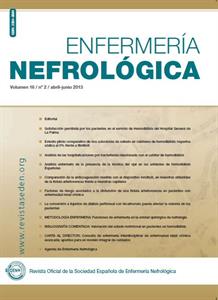Contenido del artículo principal
Resumen
El sellado de catéteres en hemodiálisis suele ser motivo de controversia entre los distintos profesio-nales dedicados a la hemodiálisis.El objetivo del presente estudio es comparar dos soluciones de sellado de catéter para hemodiálisis: heparina al 5% y fi brilin (heparina 20ui/ml + metil y propilparaben).Estudiamos 8 pacientes (mujeres) de 69±12 años portadoras de catéter tunelizado de 17±7 meses de duración del catéter, estables y que habían dado su consentimiento para el estudio. Inicialmente se selló con fibrilin durante un mes (12 sesiones) y posteriormente con heparina al 5% el mismo periodo de tiempo. Se registró velocidad de bomba, flujo efectivo, presión venosa, KT, necesidad de utilizar fibrinolíticos, infecciones, nº de manipulaciones, hipotensiones, recirculación, KT/V, TP, TPTA. Se compararon los estudios mediante t student .Después de dos meses de estudio se observó mayor flujo efectivo 318±23 ml/m en catéteres sellados con heparina frente a 307±17 ml/m con fibrilin (p= 0,008), menor presión venosa 147±12 mm Hg en heparina frente a 168±17 en fibrilin (p=0,006), mayor KT en heparina 43±3 litros frente a 41±4 litros en fibrilin. A pesar de estas mejores condiciones, clínicamente no supusieron diferencias en la eficacia dialítica KT/V heparina 1,56±0,2 frente a 1,59 ±0,2 en fibrilin. Si se observó un mayor nº de manipulaciones del catéter en heparina 12±0,2 frente a 9,4±1,3 en fi brilin (p=0,001). No existieron diferencias en aparición de infecciones, recirculación, necesidad de fibrinoliticos o alteraciones de coagulación.Concluimos que el sellado de catéteres de Hemodiálisis con Fibrilin es una alternativa eficaz a la heparina al 5%. No se acompaña de un mayor grado de disfunción del catéter y si de un menor nº de manipulaciones, lo que podría condicionar un menor nº de infecciones asociado a catéteres.
Palabras clave
Sellado; Catéter; Heparina 5%; Fibrilin.
Detalles del artículo
Licencia
Aviso de derechos de autor/a
© Los autores ceden de forma no exclusiva los derechos de explotación de los trabajos publicados y consiente en que su uso y distribución se realice con la Licencia Creative Commons Atribución - No comercial 4.0 Internacional (CC BY-NC 4.0). Puede consultar desde aquí la versión informativa y el texto legal de la licencia. Esta circunstancia ha de hacerse constar expresamente de esta forma cuando sea necesario.
Cómo citar
1.
Fernández Rivera C, Lamela Rivas L, Ornosa Agra M del C. Estudio piloto comparativo de dos soluciones de sellado en catéteres de hemodiálisis:heparina sódica al 5% frente a fibrilin®. Enferm Nefrol [Internet]. 2013 [consultado 1 Nov 2025];16(2):[aprox. 5 p.]. Disponible en: https://www.enfermerianefrologica.com/revista/article/view/4182




